Leadership Approaches & Continuous Quality Improvement in Teaching
VerifiedAdded on 2023/06/12
|10
|2804
|413
Essay
AI Summary
This essay examines the crucial role of leadership approaches and continuous quality improvement (CQI) in enhancing the effectiveness and quality of clinical practice teaching. It critiques various leadership styles, including transformational, transactional, autocratic, democratic, and laissez-faire, emphasizing the importance of adapting leadership styles to different situations. The essay also explores essential leadership qualities and the impact of effective leadership on patient care, staff satisfaction, and organizational performance. Furthermore, it analyzes the integration of CQI principles into clinical teaching, advocating for a balanced approach that combines theoretical knowledge with practical experience. The author recommends that educational curricula should encourage practical application of learned concepts and that further research is needed to determine the most effective methods for instigating clinical practice experience as part of CQI training, highlighting the necessity of early leadership training to achieve quality in clinical practice and improve overall healthcare outcomes. The essay concludes that by integrating leadership approaches and CQI techniques into teaching curricula, healthcare facilities can mitigate negative outcomes and enhance patient-centered care.

Leadership approaches and continuous quality improvement of teaching in clinical
practice
Name
Institution
practice
Name
Institution
Paraphrase This Document
Need a fresh take? Get an instant paraphrase of this document with our AI Paraphraser
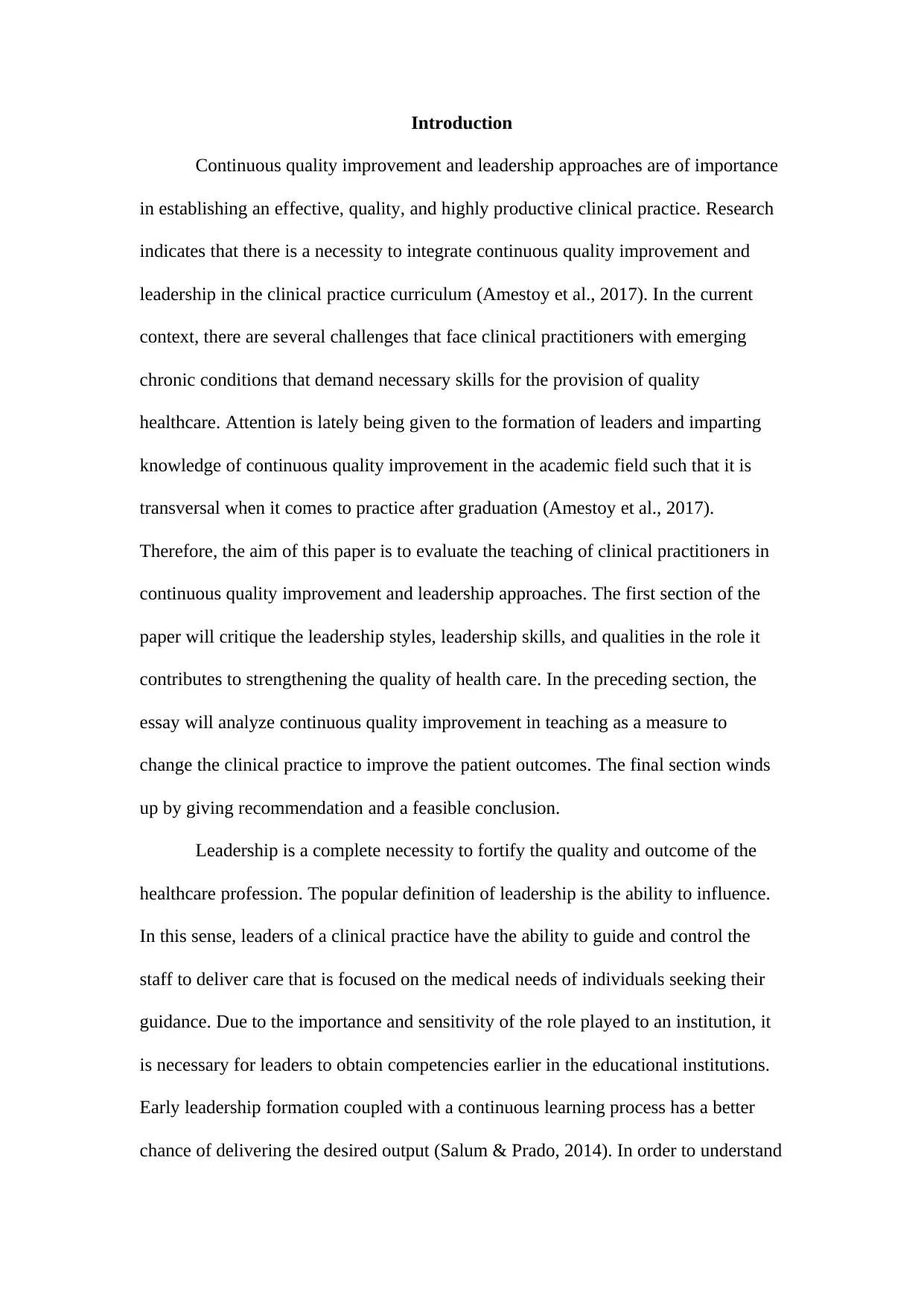
Introduction
Continuous quality improvement and leadership approaches are of importance
in establishing an effective, quality, and highly productive clinical practice. Research
indicates that there is a necessity to integrate continuous quality improvement and
leadership in the clinical practice curriculum (Amestoy et al., 2017). In the current
context, there are several challenges that face clinical practitioners with emerging
chronic conditions that demand necessary skills for the provision of quality
healthcare. Attention is lately being given to the formation of leaders and imparting
knowledge of continuous quality improvement in the academic field such that it is
transversal when it comes to practice after graduation (Amestoy et al., 2017).
Therefore, the aim of this paper is to evaluate the teaching of clinical practitioners in
continuous quality improvement and leadership approaches. The first section of the
paper will critique the leadership styles, leadership skills, and qualities in the role it
contributes to strengthening the quality of health care. In the preceding section, the
essay will analyze continuous quality improvement in teaching as a measure to
change the clinical practice to improve the patient outcomes. The final section winds
up by giving recommendation and a feasible conclusion.
Leadership is a complete necessity to fortify the quality and outcome of the
healthcare profession. The popular definition of leadership is the ability to influence.
In this sense, leaders of a clinical practice have the ability to guide and control the
staff to deliver care that is focused on the medical needs of individuals seeking their
guidance. Due to the importance and sensitivity of the role played to an institution, it
is necessary for leaders to obtain competencies earlier in the educational institutions.
Early leadership formation coupled with a continuous learning process has a better
chance of delivering the desired output (Salum & Prado, 2014). In order to understand
Continuous quality improvement and leadership approaches are of importance
in establishing an effective, quality, and highly productive clinical practice. Research
indicates that there is a necessity to integrate continuous quality improvement and
leadership in the clinical practice curriculum (Amestoy et al., 2017). In the current
context, there are several challenges that face clinical practitioners with emerging
chronic conditions that demand necessary skills for the provision of quality
healthcare. Attention is lately being given to the formation of leaders and imparting
knowledge of continuous quality improvement in the academic field such that it is
transversal when it comes to practice after graduation (Amestoy et al., 2017).
Therefore, the aim of this paper is to evaluate the teaching of clinical practitioners in
continuous quality improvement and leadership approaches. The first section of the
paper will critique the leadership styles, leadership skills, and qualities in the role it
contributes to strengthening the quality of health care. In the preceding section, the
essay will analyze continuous quality improvement in teaching as a measure to
change the clinical practice to improve the patient outcomes. The final section winds
up by giving recommendation and a feasible conclusion.
Leadership is a complete necessity to fortify the quality and outcome of the
healthcare profession. The popular definition of leadership is the ability to influence.
In this sense, leaders of a clinical practice have the ability to guide and control the
staff to deliver care that is focused on the medical needs of individuals seeking their
guidance. Due to the importance and sensitivity of the role played to an institution, it
is necessary for leaders to obtain competencies earlier in the educational institutions.
Early leadership formation coupled with a continuous learning process has a better
chance of delivering the desired output (Salum & Prado, 2014). In order to understand
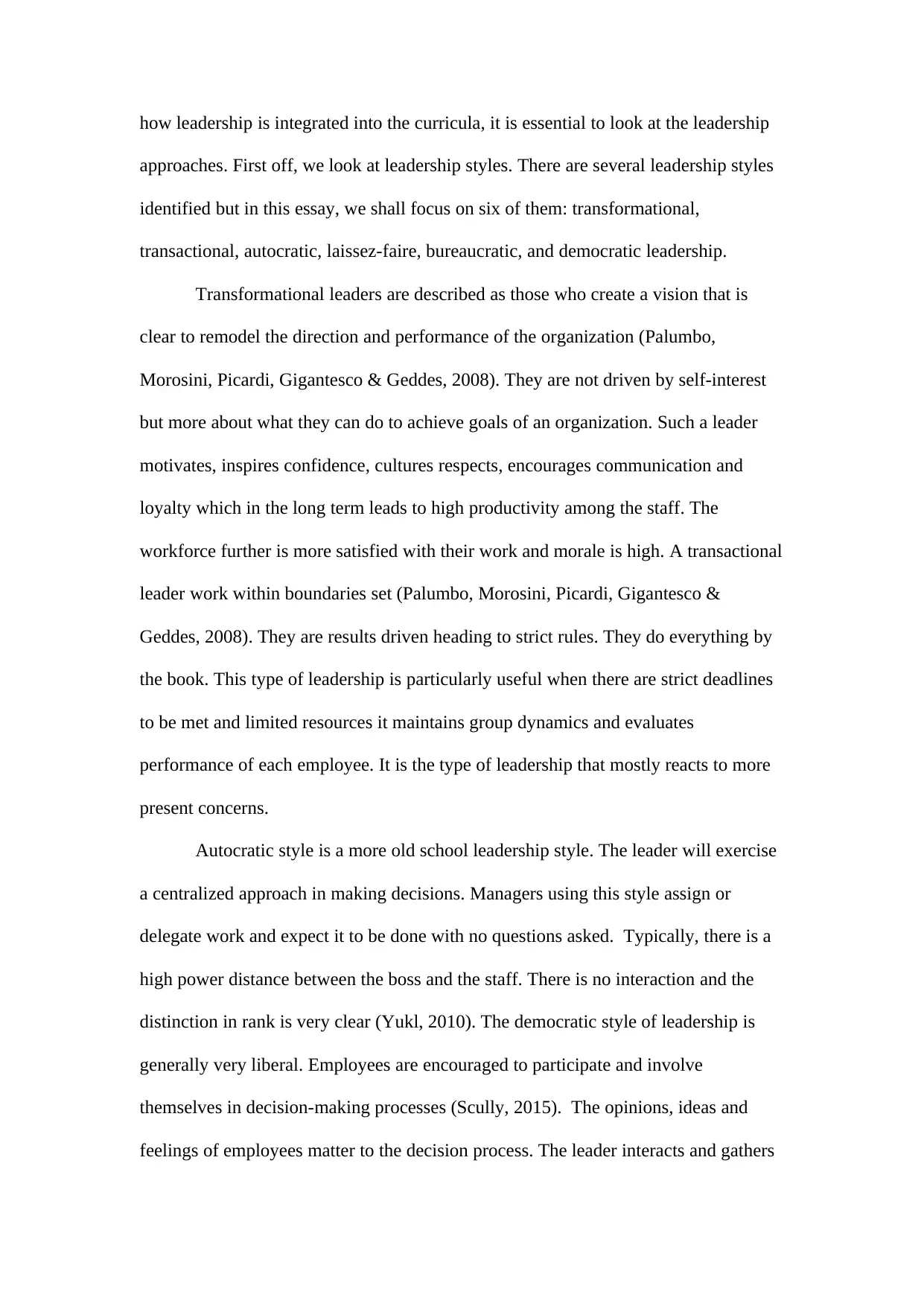
how leadership is integrated into the curricula, it is essential to look at the leadership
approaches. First off, we look at leadership styles. There are several leadership styles
identified but in this essay, we shall focus on six of them: transformational,
transactional, autocratic, laissez-faire, bureaucratic, and democratic leadership.
Transformational leaders are described as those who create a vision that is
clear to remodel the direction and performance of the organization (Palumbo,
Morosini, Picardi, Gigantesco & Geddes, 2008). They are not driven by self-interest
but more about what they can do to achieve goals of an organization. Such a leader
motivates, inspires confidence, cultures respects, encourages communication and
loyalty which in the long term leads to high productivity among the staff. The
workforce further is more satisfied with their work and morale is high. A transactional
leader work within boundaries set (Palumbo, Morosini, Picardi, Gigantesco &
Geddes, 2008). They are results driven heading to strict rules. They do everything by
the book. This type of leadership is particularly useful when there are strict deadlines
to be met and limited resources it maintains group dynamics and evaluates
performance of each employee. It is the type of leadership that mostly reacts to more
present concerns.
Autocratic style is a more old school leadership style. The leader will exercise
a centralized approach in making decisions. Managers using this style assign or
delegate work and expect it to be done with no questions asked. Typically, there is a
high power distance between the boss and the staff. There is no interaction and the
distinction in rank is very clear (Yukl, 2010). The democratic style of leadership is
generally very liberal. Employees are encouraged to participate and involve
themselves in decision-making processes (Scully, 2015). The opinions, ideas and
feelings of employees matter to the decision process. The leader interacts and gathers
approaches. First off, we look at leadership styles. There are several leadership styles
identified but in this essay, we shall focus on six of them: transformational,
transactional, autocratic, laissez-faire, bureaucratic, and democratic leadership.
Transformational leaders are described as those who create a vision that is
clear to remodel the direction and performance of the organization (Palumbo,
Morosini, Picardi, Gigantesco & Geddes, 2008). They are not driven by self-interest
but more about what they can do to achieve goals of an organization. Such a leader
motivates, inspires confidence, cultures respects, encourages communication and
loyalty which in the long term leads to high productivity among the staff. The
workforce further is more satisfied with their work and morale is high. A transactional
leader work within boundaries set (Palumbo, Morosini, Picardi, Gigantesco &
Geddes, 2008). They are results driven heading to strict rules. They do everything by
the book. This type of leadership is particularly useful when there are strict deadlines
to be met and limited resources it maintains group dynamics and evaluates
performance of each employee. It is the type of leadership that mostly reacts to more
present concerns.
Autocratic style is a more old school leadership style. The leader will exercise
a centralized approach in making decisions. Managers using this style assign or
delegate work and expect it to be done with no questions asked. Typically, there is a
high power distance between the boss and the staff. There is no interaction and the
distinction in rank is very clear (Yukl, 2010). The democratic style of leadership is
generally very liberal. Employees are encouraged to participate and involve
themselves in decision-making processes (Scully, 2015). The opinions, ideas and
feelings of employees matter to the decision process. The leader interacts and gathers
⊘ This is a preview!⊘
Do you want full access?
Subscribe today to unlock all pages.

Trusted by 1+ million students worldwide
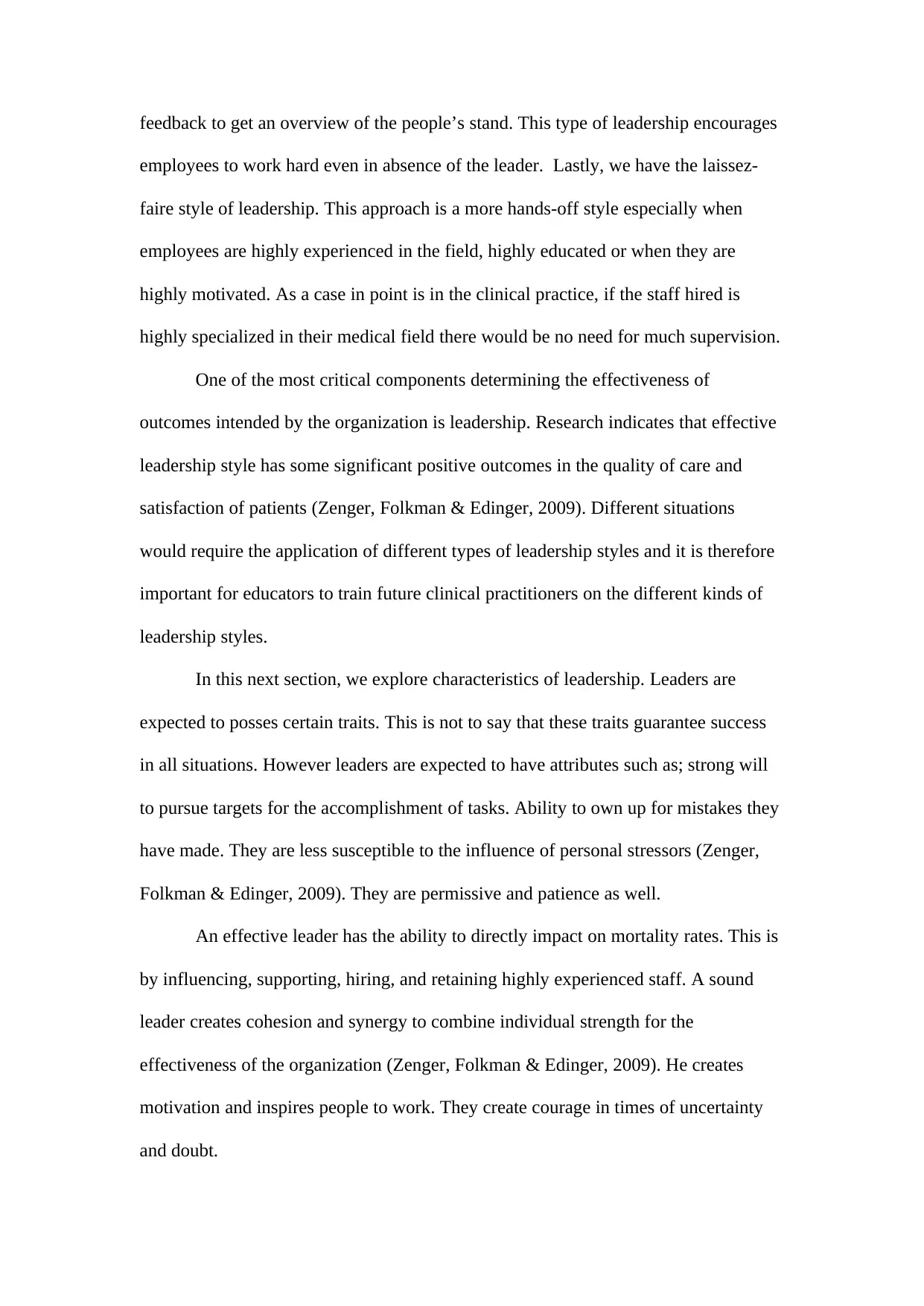
feedback to get an overview of the people’s stand. This type of leadership encourages
employees to work hard even in absence of the leader. Lastly, we have the laissez-
faire style of leadership. This approach is a more hands-off style especially when
employees are highly experienced in the field, highly educated or when they are
highly motivated. As a case in point is in the clinical practice, if the staff hired is
highly specialized in their medical field there would be no need for much supervision.
One of the most critical components determining the effectiveness of
outcomes intended by the organization is leadership. Research indicates that effective
leadership style has some significant positive outcomes in the quality of care and
satisfaction of patients (Zenger, Folkman & Edinger, 2009). Different situations
would require the application of different types of leadership styles and it is therefore
important for educators to train future clinical practitioners on the different kinds of
leadership styles.
In this next section, we explore characteristics of leadership. Leaders are
expected to posses certain traits. This is not to say that these traits guarantee success
in all situations. However leaders are expected to have attributes such as; strong will
to pursue targets for the accomplishment of tasks. Ability to own up for mistakes they
have made. They are less susceptible to the influence of personal stressors (Zenger,
Folkman & Edinger, 2009). They are permissive and patience as well.
An effective leader has the ability to directly impact on mortality rates. This is
by influencing, supporting, hiring, and retaining highly experienced staff. A sound
leader creates cohesion and synergy to combine individual strength for the
effectiveness of the organization (Zenger, Folkman & Edinger, 2009). He creates
motivation and inspires people to work. They create courage in times of uncertainty
and doubt.
employees to work hard even in absence of the leader. Lastly, we have the laissez-
faire style of leadership. This approach is a more hands-off style especially when
employees are highly experienced in the field, highly educated or when they are
highly motivated. As a case in point is in the clinical practice, if the staff hired is
highly specialized in their medical field there would be no need for much supervision.
One of the most critical components determining the effectiveness of
outcomes intended by the organization is leadership. Research indicates that effective
leadership style has some significant positive outcomes in the quality of care and
satisfaction of patients (Zenger, Folkman & Edinger, 2009). Different situations
would require the application of different types of leadership styles and it is therefore
important for educators to train future clinical practitioners on the different kinds of
leadership styles.
In this next section, we explore characteristics of leadership. Leaders are
expected to posses certain traits. This is not to say that these traits guarantee success
in all situations. However leaders are expected to have attributes such as; strong will
to pursue targets for the accomplishment of tasks. Ability to own up for mistakes they
have made. They are less susceptible to the influence of personal stressors (Zenger,
Folkman & Edinger, 2009). They are permissive and patience as well.
An effective leader has the ability to directly impact on mortality rates. This is
by influencing, supporting, hiring, and retaining highly experienced staff. A sound
leader creates cohesion and synergy to combine individual strength for the
effectiveness of the organization (Zenger, Folkman & Edinger, 2009). He creates
motivation and inspires people to work. They create courage in times of uncertainty
and doubt.
Paraphrase This Document
Need a fresh take? Get an instant paraphrase of this document with our AI Paraphraser
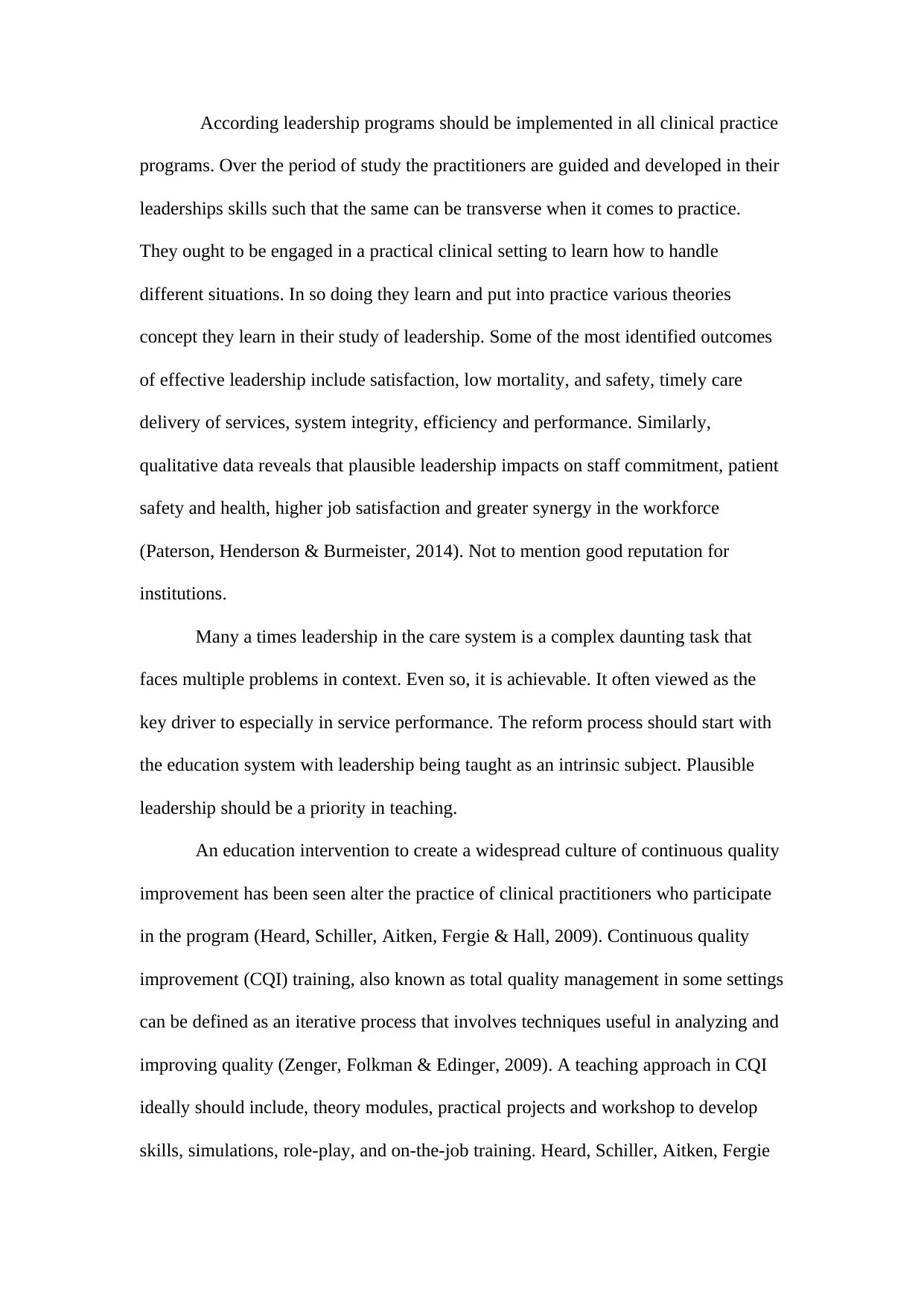
According leadership programs should be implemented in all clinical practice
programs. Over the period of study the practitioners are guided and developed in their
leaderships skills such that the same can be transverse when it comes to practice.
They ought to be engaged in a practical clinical setting to learn how to handle
different situations. In so doing they learn and put into practice various theories
concept they learn in their study of leadership. Some of the most identified outcomes
of effective leadership include satisfaction, low mortality, and safety, timely care
delivery of services, system integrity, efficiency and performance. Similarly,
qualitative data reveals that plausible leadership impacts on staff commitment, patient
safety and health, higher job satisfaction and greater synergy in the workforce
(Paterson, Henderson & Burmeister, 2014). Not to mention good reputation for
institutions.
Many a times leadership in the care system is a complex daunting task that
faces multiple problems in context. Even so, it is achievable. It often viewed as the
key driver to especially in service performance. The reform process should start with
the education system with leadership being taught as an intrinsic subject. Plausible
leadership should be a priority in teaching.
An education intervention to create a widespread culture of continuous quality
improvement has been seen alter the practice of clinical practitioners who participate
in the program (Heard, Schiller, Aitken, Fergie & Hall, 2009). Continuous quality
improvement (CQI) training, also known as total quality management in some settings
can be defined as an iterative process that involves techniques useful in analyzing and
improving quality (Zenger, Folkman & Edinger, 2009). A teaching approach in CQI
ideally should include, theory modules, practical projects and workshop to develop
skills, simulations, role-play, and on-the-job training. Heard, Schiller, Aitken, Fergie
programs. Over the period of study the practitioners are guided and developed in their
leaderships skills such that the same can be transverse when it comes to practice.
They ought to be engaged in a practical clinical setting to learn how to handle
different situations. In so doing they learn and put into practice various theories
concept they learn in their study of leadership. Some of the most identified outcomes
of effective leadership include satisfaction, low mortality, and safety, timely care
delivery of services, system integrity, efficiency and performance. Similarly,
qualitative data reveals that plausible leadership impacts on staff commitment, patient
safety and health, higher job satisfaction and greater synergy in the workforce
(Paterson, Henderson & Burmeister, 2014). Not to mention good reputation for
institutions.
Many a times leadership in the care system is a complex daunting task that
faces multiple problems in context. Even so, it is achievable. It often viewed as the
key driver to especially in service performance. The reform process should start with
the education system with leadership being taught as an intrinsic subject. Plausible
leadership should be a priority in teaching.
An education intervention to create a widespread culture of continuous quality
improvement has been seen alter the practice of clinical practitioners who participate
in the program (Heard, Schiller, Aitken, Fergie & Hall, 2009). Continuous quality
improvement (CQI) training, also known as total quality management in some settings
can be defined as an iterative process that involves techniques useful in analyzing and
improving quality (Zenger, Folkman & Edinger, 2009). A teaching approach in CQI
ideally should include, theory modules, practical projects and workshop to develop
skills, simulations, role-play, and on-the-job training. Heard, Schiller, Aitken, Fergie

& Hall (2009) argue that most academic institutions administered by institutions are
mostly classroom based. Even so, there is an accumulating acceptance of the value of
combining a variety of disciplines together in teams for a shared educational
experience predominantly in practical fields. Fortunately, there is a worldwide
growing inclination to teaching that reinforces practice to acquire skills while on the
job.
Transformation in the clinical practice requires the use of new pedagogies that
integrate quality improvement an essential part of the clinical practice. Varkey, Reller,
Smith, Allan, Ponto & Osborn (2008) explain that teachers should create
environments that allow students to practice what is taught in class to improve patient
outcomes. They also emphasize that assessment of clinical practices should not just be
on an individual level but also for the groups in the practice and whether they were
able to work together to improve the care system. It is certain that in some cases
medical practitioners undertake training to improve quality in their academic
preparatory training (Thanh, Jacobs, Wanke, Hense & Sauve, 2010). However, there
is little to almost no follow up to evaluate the long-term learning outcomes in the
practice of registered clinical practitioners. A sustainable learning can only be
achieved if quality improvement is taught and reinforces as a continuous process.
Evidence by researchers indicates that plain classroom-based training and
online training is likely to contribute to a dysfunctional, severally troubled healthcare
system (Bennett, 2016). It is recommended that recognition of the process begins with
the learning and practice as well as structures that support healthcare in determining
the outcomes of the clinical practice. A balance between theory taught in the
classrooms and the actual hands-on experience is yet to be attained globally. Newly
qualified physicians are in trained to focus on care of patients with particular
mostly classroom based. Even so, there is an accumulating acceptance of the value of
combining a variety of disciplines together in teams for a shared educational
experience predominantly in practical fields. Fortunately, there is a worldwide
growing inclination to teaching that reinforces practice to acquire skills while on the
job.
Transformation in the clinical practice requires the use of new pedagogies that
integrate quality improvement an essential part of the clinical practice. Varkey, Reller,
Smith, Allan, Ponto & Osborn (2008) explain that teachers should create
environments that allow students to practice what is taught in class to improve patient
outcomes. They also emphasize that assessment of clinical practices should not just be
on an individual level but also for the groups in the practice and whether they were
able to work together to improve the care system. It is certain that in some cases
medical practitioners undertake training to improve quality in their academic
preparatory training (Thanh, Jacobs, Wanke, Hense & Sauve, 2010). However, there
is little to almost no follow up to evaluate the long-term learning outcomes in the
practice of registered clinical practitioners. A sustainable learning can only be
achieved if quality improvement is taught and reinforces as a continuous process.
Evidence by researchers indicates that plain classroom-based training and
online training is likely to contribute to a dysfunctional, severally troubled healthcare
system (Bennett, 2016). It is recommended that recognition of the process begins with
the learning and practice as well as structures that support healthcare in determining
the outcomes of the clinical practice. A balance between theory taught in the
classrooms and the actual hands-on experience is yet to be attained globally. Newly
qualified physicians are in trained to focus on care of patients with particular
⊘ This is a preview!⊘
Do you want full access?
Subscribe today to unlock all pages.

Trusted by 1+ million students worldwide

situations. Little attention is paid to teaching clinical professionals on the necessary
skills to improve healthcare and progressive safety of the patients. The physicians
only acquire knowledge in science. CQI offers a systematic approach in beginning at
entrance requirements for students for the clinical practice curriculum (Barach,
Jacobs, Lipshultz & Laussen, 2011). Followed by a well-structured curriculum.
Setting of an organization culture for training environment. Assessment of students
and teams they are assigned to. Then finally evaluating the outcomes of the training.
There is an overemphasis to focus training on doctors and nurses leaving out
other key players of the practice. Other key player include, support workers, health
professionals, assistants, and management (Barach, Jacobs, Lipshultz & Laussen,
2011). Sadly, there is a deficiency in training material that supports the
aforementioned additional key players to practice quality improvement. Managers
taught quality improvement techniques are only directed towards overseeing and
controlling process (Thanh, Jacobs, Wanke, Hense & Sauve, 2010). There is a visible
gap to train managers to manage change, implement change, recognize the need for
change, direct the change and evaluate the impact. Understanding and learning the
wider aspects of quality improvement will be a wide step to transforming the clinical
practice into a more patient centered practice (Barach, Jacobs, Lipshultz & Laussen,
2011).
Recommendations
More research should go into determining the most effective methods of
instigating clinical practice experience as part of continuous quality improvement
training since it is still unknown what technique would work best. Educational
curriculum should encourage the participants to practice what is taught in class, as
general education alone is not enough to improve clinical practice in the long run.
skills to improve healthcare and progressive safety of the patients. The physicians
only acquire knowledge in science. CQI offers a systematic approach in beginning at
entrance requirements for students for the clinical practice curriculum (Barach,
Jacobs, Lipshultz & Laussen, 2011). Followed by a well-structured curriculum.
Setting of an organization culture for training environment. Assessment of students
and teams they are assigned to. Then finally evaluating the outcomes of the training.
There is an overemphasis to focus training on doctors and nurses leaving out
other key players of the practice. Other key player include, support workers, health
professionals, assistants, and management (Barach, Jacobs, Lipshultz & Laussen,
2011). Sadly, there is a deficiency in training material that supports the
aforementioned additional key players to practice quality improvement. Managers
taught quality improvement techniques are only directed towards overseeing and
controlling process (Thanh, Jacobs, Wanke, Hense & Sauve, 2010). There is a visible
gap to train managers to manage change, implement change, recognize the need for
change, direct the change and evaluate the impact. Understanding and learning the
wider aspects of quality improvement will be a wide step to transforming the clinical
practice into a more patient centered practice (Barach, Jacobs, Lipshultz & Laussen,
2011).
Recommendations
More research should go into determining the most effective methods of
instigating clinical practice experience as part of continuous quality improvement
training since it is still unknown what technique would work best. Educational
curriculum should encourage the participants to practice what is taught in class, as
general education alone is not enough to improve clinical practice in the long run.
Paraphrase This Document
Need a fresh take? Get an instant paraphrase of this document with our AI Paraphraser

There is still a gap existing in the leadership of the clinic practice. Addressing this gap
requires early training on leadership to achieve quality.
Conclusion
Today more than ever, the clinical field seeks that clinical practitioners should
be sufficiently equipped though their education. There is the need to educate better
since the existing practices are not sufficient in the outcomes. Effective leadership is
correlated to with the quality of care and outcomes. From this review, it is evident that
there is still more that should be done to integrate leadership approaches and
continuous qualitative techniques into the teaching curricula. To achieve the
objectives of a clinical practice, therefore, clinical practitioners should be cultured
earlier in their education programs. Emphasis should be placed not just on the
theoretic studies of the clinical practice but also on the practical bit. If this is practiced
worldwide, the healthcare facilities will mitigate all the negative outcomes that are
currently facing the practice.
requires early training on leadership to achieve quality.
Conclusion
Today more than ever, the clinical field seeks that clinical practitioners should
be sufficiently equipped though their education. There is the need to educate better
since the existing practices are not sufficient in the outcomes. Effective leadership is
correlated to with the quality of care and outcomes. From this review, it is evident that
there is still more that should be done to integrate leadership approaches and
continuous qualitative techniques into the teaching curricula. To achieve the
objectives of a clinical practice, therefore, clinical practitioners should be cultured
earlier in their education programs. Emphasis should be placed not just on the
theoretic studies of the clinical practice but also on the practical bit. If this is practiced
worldwide, the healthcare facilities will mitigate all the negative outcomes that are
currently facing the practice.

References
Amestoy, S., Trindade, L., Silva, G., Santos, B., Reis, V., & Ferreira, V. (2017).
Leadership in nursing: from teaching to practice in a hospital environment.
Escola Anna Nery, 21(4). doi: 10.1590/2177-9465-ean-2016-0276
Barach, P., Jacobs, J., Lipshultz, S., & Laussen, P. (2011). Pediatric and congenital
cardiac care.
Bennett, S. (2016). Continuous Improvement in Continuous Quality Control. Clinical
Chemistry, 62(10), 1299-1301. doi: 10.1373/clinchem.2016.263244
Duphily, N. (2016). Linking evidence to practice: A clinical practice guideline
project. Nursingplus Open, 2, 26-34. doi: 10.1016/j.npls.2016.09.002
Hankinson, M., Faraone, D., & Blumenfrucht, M. (2006). Sustained Improvement for
Specialty Clinic Access. The Joint Commission Journal On Quality And
Patient Safety, 32(3), 142-151. doi: 10.1016/s1553-7250(06)32019-3
Heard, S., Schiller, G., Aitken, M., Fergie, C., & Hall, L. (2009). Continuous quality
improvement: educating towards a culture of clinical governance. Quality And
Safety In Health Care, 10(Supplement 2), ii70-ii78. doi: 10.1136/qhc.0100070
Lin, B. (2010). Total quality management in health care: A survey of current
practices. Total Quality Management, 6(1), 69-78. doi:
10.1080/09544129550035602
Palumbo, G., Morosini, P., Picardi, A., Gigantesco, A., & Geddes, J. (2008).
Educating Mental Health Professionals in Clinical Epidemiology and
Continuous Quality Improvement. Administration And Policy In Mental
Health, 31(5), 421-424. doi: 10.1023/b:apih.0000034418.47370.60
Amestoy, S., Trindade, L., Silva, G., Santos, B., Reis, V., & Ferreira, V. (2017).
Leadership in nursing: from teaching to practice in a hospital environment.
Escola Anna Nery, 21(4). doi: 10.1590/2177-9465-ean-2016-0276
Barach, P., Jacobs, J., Lipshultz, S., & Laussen, P. (2011). Pediatric and congenital
cardiac care.
Bennett, S. (2016). Continuous Improvement in Continuous Quality Control. Clinical
Chemistry, 62(10), 1299-1301. doi: 10.1373/clinchem.2016.263244
Duphily, N. (2016). Linking evidence to practice: A clinical practice guideline
project. Nursingplus Open, 2, 26-34. doi: 10.1016/j.npls.2016.09.002
Hankinson, M., Faraone, D., & Blumenfrucht, M. (2006). Sustained Improvement for
Specialty Clinic Access. The Joint Commission Journal On Quality And
Patient Safety, 32(3), 142-151. doi: 10.1016/s1553-7250(06)32019-3
Heard, S., Schiller, G., Aitken, M., Fergie, C., & Hall, L. (2009). Continuous quality
improvement: educating towards a culture of clinical governance. Quality And
Safety In Health Care, 10(Supplement 2), ii70-ii78. doi: 10.1136/qhc.0100070
Lin, B. (2010). Total quality management in health care: A survey of current
practices. Total Quality Management, 6(1), 69-78. doi:
10.1080/09544129550035602
Palumbo, G., Morosini, P., Picardi, A., Gigantesco, A., & Geddes, J. (2008).
Educating Mental Health Professionals in Clinical Epidemiology and
Continuous Quality Improvement. Administration And Policy In Mental
Health, 31(5), 421-424. doi: 10.1023/b:apih.0000034418.47370.60
⊘ This is a preview!⊘
Do you want full access?
Subscribe today to unlock all pages.

Trusted by 1+ million students worldwide
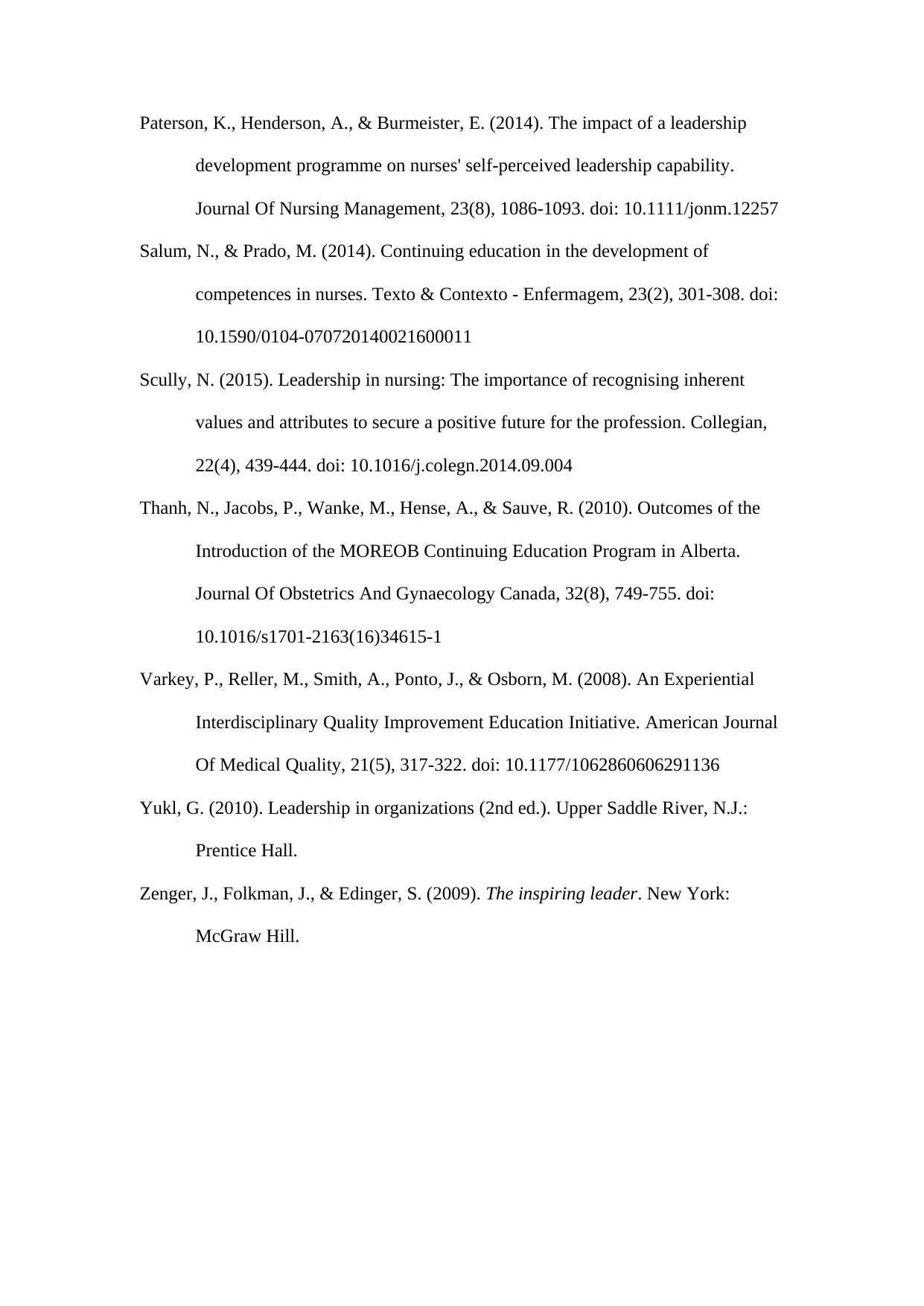
Paterson, K., Henderson, A., & Burmeister, E. (2014). The impact of a leadership
development programme on nurses' self-perceived leadership capability.
Journal Of Nursing Management, 23(8), 1086-1093. doi: 10.1111/jonm.12257
Salum, N., & Prado, M. (2014). Continuing education in the development of
competences in nurses. Texto & Contexto - Enfermagem, 23(2), 301-308. doi:
10.1590/0104-070720140021600011
Scully, N. (2015). Leadership in nursing: The importance of recognising inherent
values and attributes to secure a positive future for the profession. Collegian,
22(4), 439-444. doi: 10.1016/j.colegn.2014.09.004
Thanh, N., Jacobs, P., Wanke, M., Hense, A., & Sauve, R. (2010). Outcomes of the
Introduction of the MOREOB Continuing Education Program in Alberta.
Journal Of Obstetrics And Gynaecology Canada, 32(8), 749-755. doi:
10.1016/s1701-2163(16)34615-1
Varkey, P., Reller, M., Smith, A., Ponto, J., & Osborn, M. (2008). An Experiential
Interdisciplinary Quality Improvement Education Initiative. American Journal
Of Medical Quality, 21(5), 317-322. doi: 10.1177/1062860606291136
Yukl, G. (2010). Leadership in organizations (2nd ed.). Upper Saddle River, N.J.:
Prentice Hall.
Zenger, J., Folkman, J., & Edinger, S. (2009). The inspiring leader. New York:
McGraw Hill.
development programme on nurses' self-perceived leadership capability.
Journal Of Nursing Management, 23(8), 1086-1093. doi: 10.1111/jonm.12257
Salum, N., & Prado, M. (2014). Continuing education in the development of
competences in nurses. Texto & Contexto - Enfermagem, 23(2), 301-308. doi:
10.1590/0104-070720140021600011
Scully, N. (2015). Leadership in nursing: The importance of recognising inherent
values and attributes to secure a positive future for the profession. Collegian,
22(4), 439-444. doi: 10.1016/j.colegn.2014.09.004
Thanh, N., Jacobs, P., Wanke, M., Hense, A., & Sauve, R. (2010). Outcomes of the
Introduction of the MOREOB Continuing Education Program in Alberta.
Journal Of Obstetrics And Gynaecology Canada, 32(8), 749-755. doi:
10.1016/s1701-2163(16)34615-1
Varkey, P., Reller, M., Smith, A., Ponto, J., & Osborn, M. (2008). An Experiential
Interdisciplinary Quality Improvement Education Initiative. American Journal
Of Medical Quality, 21(5), 317-322. doi: 10.1177/1062860606291136
Yukl, G. (2010). Leadership in organizations (2nd ed.). Upper Saddle River, N.J.:
Prentice Hall.
Zenger, J., Folkman, J., & Edinger, S. (2009). The inspiring leader. New York:
McGraw Hill.
1 out of 10
Related Documents
Your All-in-One AI-Powered Toolkit for Academic Success.
+13062052269
info@desklib.com
Available 24*7 on WhatsApp / Email
![[object Object]](/_next/static/media/star-bottom.7253800d.svg)
Unlock your academic potential
Copyright © 2020–2025 A2Z Services. All Rights Reserved. Developed and managed by ZUCOL.





